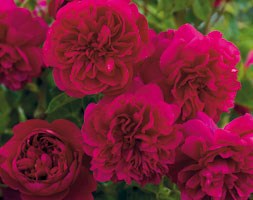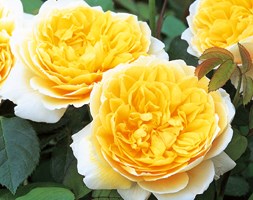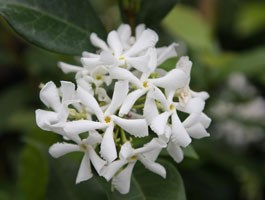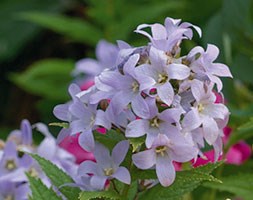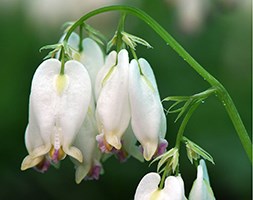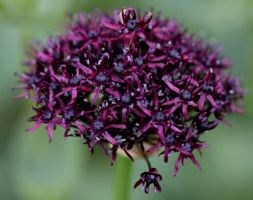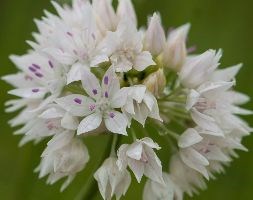New products at Crocus
by Sarah - August 31st, 2013.Filed under: Crocus, New Products.
Crocus just added these new items
Rosa Carolyn Knight (‘Austurner’) (PBR) (rose Carolyn Knight (shrub)) £25.95
Position: full sun Soil: fertile, humus-rich, moist, well-drained soil Rate of growth: fast-growing Flowering period: June to September Flower colour: Other features: excellent cut-flowers Hardiness: fully hardy All our roses are grown in an open field and then dug up when the weather conditions are right in October or November. Some suppliers send out their roses as ‘bare root’ plants (ie without pots or compost), but we pot ours up as it helps to keep the roots hydrated and in good condition. As they are dormant throughout the winter, they will not produce any new roots until spring, so don’t be surprised if the compost falls away from the roots when you take them out of their pots. The roses can be kept in their pots throughout the winter provided they are kept well fed and watered, however ideally they should planted out as soon as possible. They will already have been cut back so no further pruning will be required, apart from snipping off any tips that have died back. Routine pruning can begin in late winter the year after planting. Garden care: If planting in winter, choose a frost-free spell when the soil is not frozen. Roses are quite deep-rooted plants so dig a deep hole roughly twice as wide as the plants roots and mix in a generous amount of composted organic matter. A top-dressing of a general purpose fertiliser can be worked into the surrounding soil and we also recommend using Rose Rootgrow at this stage to encourage better root development. This is particularly important when planting into a bed where roses have previously been grown as Rose Rootgrow is said to combat rose sickness (aka. replant disease). Remove the plants from their pots and gently spread out the roots before placing them in the centre of the hole. Try to ensure that the ‘bud union’ (the point where the cultivated rose has been grafted onto the rootstock, and from where the shoots emerge) is at soil level. You can judge this quite easily by laying something flat, like a spade handle or bamboo cane, across the top of the hole. When they are at the right height, back-fill the hole, firming the soil down gently before watering the plant well. Water generously until well established, and apply a specialist rose fertiliser (following the manufacturers instructions) each spring. They will also benefit from a generous mulch of composted farmyard manure in spring, but make sure this is kept awa
Rosa Thomas à Becket (‘Auswinston’) (PBR) (rose Thomas à Becket (shrub)) £25.95
Position: full sun Soil: fertile, humus-rich, moist, well-drained soil Rate of growth: fast-growing Flowering period: June to September Flower colour: Other features: excellent cut-flowers Hardiness: fully hardy All our roses are grown in an open field and then dug up when the weather conditions are right in October or November. Some suppliers send out their roses as ‘bare root’ plants (ie without pots or compost), but we pot ours up as it helps to keep the roots hydrated and in good condition. As they are dormant throughout the winter, they will not produce any new roots until spring, so don’t be surprised if the compost falls away from the roots when you take them out of their pots. The roses can be kept in their pots throughout the winter provided they are kept well fed and watered, however ideally they should planted out as soon as possible. They will already have been cut back so no further pruning will be required, apart from snipping off any tips that have died back. Routine pruning can begin in late winter the year after planting. Garden care: If planting in winter, choose a frost-free spell when the soil is not frozen. Roses are quite deep-rooted plants so dig a deep hole roughly twice as wide as the plants roots and mix in a generous amount of composted organic matter. A top-dressing of a general purpose fertiliser can be worked into the surrounding soil and we also recommend using Rose Rootgrow at this stage to encourage better root development. This is particularly important when planting into a bed where roses have previously been grown as Rose Rootgrow is said to combat rose sickness (aka. replant disease). Remove the plants from their pots and gently spread out the roots before placing them in the centre of the hole. Try to ensure that the ‘bud union’ (the point where the cultivated rose has been grafted onto the rootstock, and from where the shoots emerge) is at soil level. You can judge this quite easily by laying something flat, like a spade handle or bamboo cane, across the top of the hole. When they are at the right height, back-fill the hole, firming the soil down gently before watering the plant well. Water generously until well established, and apply a specialist rose fertiliser (following the manufacturers instructions) each spring. They will also benefit from a generous mulch of composted farmyard manure in spring, but make sure this is kept awa
Rosa Charlotte (‘Auspoly’) (PBR) (rose Charlotte (shrub)) £25.95
Position: full sun Soil: fertile, humus-rich, moist, well-drained soil Rate of growth: fast-growing Flowering period: June to September Flower colour: Other features: excellent cut-flowers Hardiness: fully hardy All our roses are grown in an open field and then dug up when the weather conditions are right in October or November. Some suppliers send out their roses as ‘bare root’ plants (ie without pots or compost), but we pot ours up as it helps to keep the roots hydrated and in good condition. As they are dormant throughout the winter, they will not produce any new roots until spring, so don’t be surprised if the compost falls away from the roots when you take them out of their pots. The roses can be kept in their pots throughout the winter provided they are kept well fed and watered, however ideally they should planted out as soon as possible. They will already have been cut back so no further pruning will be required, apart from snipping off any tips that have died back. Routine pruning can begin in late winter the year after planting. Garden care: If planting in winter, choose a frost-free spell when the soil is not frozen. Roses are quite deep-rooted plants so dig a deep hole roughly twice as wide as the plants roots and mix in a generous amount of composted organic matter. A top-dressing of a general purpose fertiliser can be worked into the surrounding soil and we also recommend using Rose Rootgrow at this stage to encourage better root development. This is particularly important when planting into a bed where roses have previously been grown as Rose Rootgrow is said to combat rose sickness (aka. replant disease). Remove the plants from their pots and gently spread out the roots before placing them in the centre of the hole. Try to ensure that the ‘bud union’ (the point where the cultivated rose has been grafted onto the rootstock, and from where the shoots emerge) is at soil level. You can judge this quite easily by laying something flat, like a spade handle or bamboo cane, across the top of the hole. When they are at the right height, back-fill the hole, firming the soil down gently before watering the plant well. Water generously until well established, and apply a specialist rose fertiliser (following the manufacturers instructions) each spring. They will also benefit from a generous mulch of composted farmyard manure in spring, but make sure this is kept awa
Trachelospermum jasminoides (star jasmine) £14.99
Position: full sun Soil: fertile, well-drained soil Rate of growth: average Flowering period: June to August Flower colour: white flowers Other features: very fragrant flowers Hardiness: frost hardy (needs winter protection) An attractive woody, evergreen climber with rich, dark green leaves which turn bronze in winter. Clusters of fragrant, pure white flowers are produced from mid- to late summer. It is best grown against a warm, sunny wall in milder areas or in a greenhouse or conservatory in areas prone to severe frosts. Garden care: After flowering has finished prune back to fit the available space. In frost prone areas, grow in pots of loam-based potting compost, such as John Innes No2 and move to a frost-free spot in winter.
Campanula lactiflora (milky bellflower) £7.99
Position: full sun or partial shade Soil: fertile, moist, well-drained, neutral to alkaline soil Rate of growth: average to fast-growing Flowering period: July to September Hardiness: ful ly hardyTall, branching stems bearing clusters of deep lilac or sla te-blue, open, bell-shaped flowers appear from July to September among toothed, mid-green leaves. This tall bellflower is a cottage-garden classic and is perfec t towards the back of a mixed or herbaceous border. It’s a happy companion for old roses, self-seeds freely, and the flower colour is retained best in partial shade. Garden care: Protect the tender foliage from slugs and deadhead regularly to prolong flowering and prevent seeding. Apply a generous 5-7cm (2-3in) mulch of well-rotted compost around the base of the plant in spring. Stake with bamboo canes or brushwood in spring before the flowers ap pear.
Dicentra ‘Aurora’ (wild bleeding heart) £7.99
Position: full sun or partial shade Soil: moist, humus-rich, preferably neutral to slightly alkaline Rate of growth: average Flowering period: May to August Hardiness: fully hardy A fast-growing, dwarf perennial with arching stems of creamy white, heart-shaped flowers from late spring to late summer. The blue-green, fern-like foliage forms a soft mound, and is a lovely foil to other plants. Easy to grow, it looks great planted en masse as a groundcover at the front of a shady border or as part of a cottage garden scheme. Dicentras are northern hemisphere plants, growing from Asia to North America. In their natural habitat they are found in moist soils in the cool margins of woodlands. Garden care: Dicentras are happy in any good garden soil that is fertile but not too heavy. Enrich the soil with plenty of leaf mould before planting and apply a mulch in autumn, too. A light fertilising in March will help enormously.
Allium atropurpureum (ornamental onion bulbs) £4.99
Position: full sun Soil: fertile, well-drained soil Rate of growth: average to fast Flowering period: May to June Hardiness: fully hardy Bulb size: 7/8 A new addition to our range of Alliums, that immediately shot to the top of our wish-lists. In early to mid summer, each upright stem is crowned with a rounded cluster of small flowers, which seem to hover like large, brilliantly coloured jewels above the foliage. Each flower is made up of deep pink to purple petals surrounding a blueberry-purple centre, which creates a vibrant and exciting contrast of colours. Their drumstick shape is great for adding diversity to the border, while their sturdy stems makes them ideal for cutting. If left in the border after the flowers have faded though, the subsequent seed heads will add months of structural interest. Garden care: Plant bulbs 15cm deep and 15cm apart to enjoy the full effect of the flowers. Avoid excessive moisture from late summer when they become dormant. Over-large clumps can be lifted and divided in autumn or spring.
Allium amplectens ‘Graceful Beauty’ (allium bulbs) £3.99
Position: full sun Soil: fertile, well-drained soil Rate of growth: average Flowering period: April-May Hardiness: fully hardy Garden care: Plant bulbs 5cm deep and 5cm apart to enjoy the full effect of the flowers. Avoid excessive soil moisture, and split and divide large clumps in autumn or spring.








